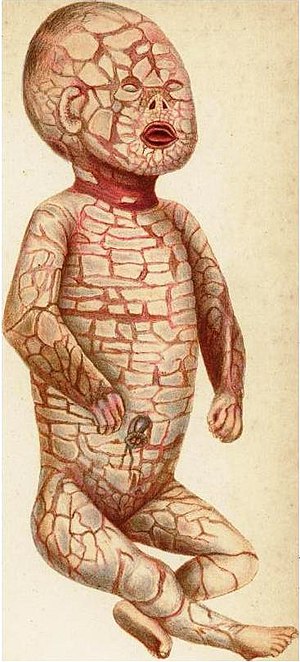Harlequin-type ichthyosis
| Harlequin-type ichthyosis | |
|---|---|
| Synonyms | harlequin ichthyosis,hyosis fetalis, keratosis diffusa fetalis, harlequin fetus,ichthyosis congenita gravior |
 |
|
| Harlequin fetus (1886) | |
| Classification and external resources | |
| Specialty | Dermatology |
| ICD-10 | Q80.4 |
| ICD-9-CM | 757.1 |
| OMIM | 242500 |
| DiseasesDB | 30052 |
| eMedicine | derm/192 |
| MeSH | D017490 |
| Orphanet | 457 |
Harlequin-type ichthyosis is a very rare severe genetic disease, which causes thickening of the skin. At birth, the child’s whole body is encased in an 'armor' of thick white plates of skin, separated by deep cracks. In addition, the eyes, ears, penis, and limbs may be abnormally contracted. Because of resultant cracked skin in locations where normal skin would fold, it is easily pregnable by bacteria and other contaminants, which can result in serious risk of fatal infection.
It is an autosomal recessive congenital ichthyosis, which is a group of nonsyndromic disorders of keratinization. It is associated with a mutation in the gene for the protein ABCA12. The disease can be diagnosed in the uterus by way of fetal skin biopsy or by analysis of amniotic fluid cells obtained by amniocentesis. Common features of the disease can be recognized through ultrasound, and follow up with 3D ultrasound to diagnose the condition. Ultrasound can reveal abnormal facial features with ectropion, eclabium, short foot length, incurved toes, clenched fists, poor delineation of nostrils, and polyhydramnios.
Constant care is required to moisturize and protect the skin. The overall rate of harlequin ichthyosis is 1 in 300,000 births. The harlequin-type designation comes from the diamond shape of the scales at birth (resembling the costume of Arlecchino).
Newborns with harlequin-type ichthyosis present with thick, fissured armor-plate hyperkeratosis. Sufferers feature severe cranial and facial deformities. The ears may be very poorly developed or absent entirely, as may the nose. The eyelids may be everted (ectropion), which leaves the eyes and the area around them very susceptible to infection. Babies with this condition often bleed during birth. The lips are pulled back by the dry skin (eclabium). Joints are sometimes lacking in movement, and may be below the normal size. Hypoplasia is sometimes found in the fingers. Polydactyly has also been found on occasion. In addition, the fish mouth appearance, mouth breathing, and xerostomia place affected individuals at extremely high risk for developing rampant dental decay.
...
Wikipedia
